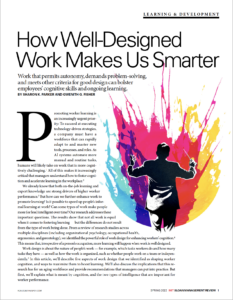
As technology shifts to automate more on-the-job processes, occupational health researchers, such as Gwen Fisher from the Department of Psychology, are studying ways to design workplaces to foster new learning, autonomy, and problem-solving in support of worker health and well-being. After all, the average human spends 13 years of life dedicated to work, and evidence suggests that a poorly designed work environment can increase an individual’s likelihood of developing dementia.
A March 2022 publication from Fisher and colleague Sharon Parker of Australia’s Curtin University explores this relationship between work design and cognitive skills. The study, published in The MIT Sloan Management Review, identifies five aspects of work design that support worker cognition, including job autonomy, feedback, job complexity, social relationships at work, and job demands.
To identify these qualities, Fisher and Parker conducted a meta-analysis of 180 scholarly articles about work and cognition from disciplines such as neuroscience, public health, aging, experimental psychology, gerontology, and management.
“This research highlights ways that job design can be helpful and beneficial for workers’ health and well-being. Jobs that provide workers with autonomy, feedback, learning, and less stress are desirable and beneficial,” said Fisher, who brings expertise in cognitive functioning and occupational health to the study. Parker, who led this work, is a renowned expert on work design.
To support worker performance in the 21st century workplace, the researchers first had to connect how work design relates to crystallized and fluid intelligence, the foundation of cognition.
Crystalized vs. fluid intelligence
Crystalized intelligence refers to knowledge that is stored and built upon over time, like the skill of riding a bike. Fluid intelligence is more focused on the ability to pay attention, memorize, process, and reason with information.
While crystalized intelligence seems to continually increase throughout life, fluid intelligence tends to decline with age. Yet when a workplace is well-designed, it can aid in developing workers’ cognition in both the short and long run because the mind is consistently active and engaged. Fisher and Parker propose that a workplace can promote a longer period of healthy cognition if the workplace meets a few standards.
Powered by RedCircle
A recipe for success
The researchers’ findings identify five qualities that are linked to a cognition preservation pathway, commonly referred to as the “use it or lose it” process:
- Job autonomy refers to the amount of independence and opportunity an employee has when choosing how and when to work. When workers have greater job autonomy, they feel a greater sense of ownership over their work, which encourages them to perform at a higher level.
- Feedback refers to the information that a worker receives about their work. This information allows an employee to reevaluate and understand which strategies are working and which are not.
- Job complexity describes how difficult or demanding a particular job is. When a job is more complex, it allows an employee the opportunity to think critically and creatively to get their job done.
- Relational aspects refer to social interactions that come with a specific job. When employees are supported by co-workers and bosses, it empowers them to continually learn and develop their understanding of their job.
- Psychosocial job demands deal with the emotional elements of a job. Reasonable hours, tasks, deadlines, and a clear definition of roles are just a few aspects of a workplace that contribute to workers’ emotions.
When these aspects are incorporated into the workplace, the study shows an increase in workers’ abilities to develop their cognition and a reduction in age-related declines in cognitive health.

Prevention of cognitive decline
An additional finding of Fisher and Parker’s work is the implication that good work design is linked to a lowered risk of cognitive decline and cognition-related diseases, such as Alzheimer’s and dementia.
“An important variable in our review was to rule out the possibility that people with higher cognitive capabilities choose more demanding or autonomous jobs,” Fisher said. “Rather, our evidence suggests that whether work design positively or negatively affects your cognition, it will not be noticeable until later in life.”
However, some studies do show that the longer an individual has been in an active, demanding, and well-designed job, the better their cognitive outcome. Furthermore, job performance does not decrease with age, despite the natural loss of fluid intelligence; in fact, a well-designed workplace might increase the longevity of cognitive abilities in older adults by reducing the degree to which fluid intelligence is lost, and boosting and maintaining crystallized intelligence, leading to overall healthier cognitive aging.
And, when an individual works a job for years on end, they become an expert at what they do and can provide wisdom to younger employees in the field: a positive argument for having social relationships at work.
The future of work
With pandemic effects, such as the “Great Resignation” and the national commentary on the future of work, finding a well-designed job might be easier now than it ever has been. Fisher and Parker might even say that it’s essential, as a well-designed workplace has a positive effect on age-related cognitive health.
As a follow-up, the researchers are considering developing a workplace intervention study that tests the findings gathered in this latest review.
“We would enjoy being able to conduct a work design intervention in which jobs are modified to increase autonomy, feedback, and learning and then observe how workers’ cognition changes in relation to those changes in job design,” Fisher said.
“The world’s population is slowly aging, so understanding the multitude of ways that the aging process can be more graceful is of importance in research,” she added.